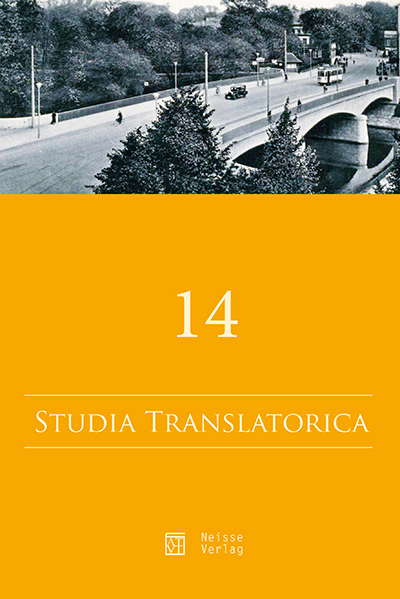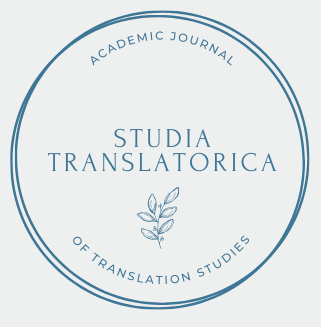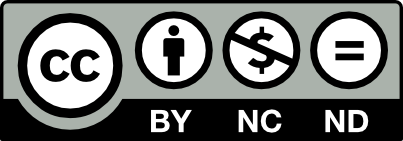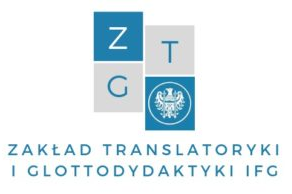
Studia Translatorica
Heft 14 (2023): Wielowymiarowość translacji. Mehrdimensionalität der Translation. Multidimensionality of Translation
Herausgegeben von: Anna Małgorzewicz, Michał Gąska
Juristische Polylexeme in der Phraseologie, der Wortbildung und der Übersetzung / Legal polylexemes in phraseology, word formation and translation
DOI: 10.23817/strans.14-1 (online zugänglich: 2024-01-20)
Datum der Einreichung: 2023-03-29
Datum der Annahme zum Druck: 2023-06-22
Schlüsselwörter: language of law, translation, phraseology, word formation, polylexemes
In the so-called analytical languages, polylexemes function as the most dominant form of naming. In German, they occur less often, because it prefers compound words in the same role. These interlingual differences raise different problems in their translation. In research literature, polylexemes are studied with different focuses and consequently treated differently. This article will first discuss the status of legal polylexemes in phraseology. Subsequently, the similarities between polylexemes and German composites will be shown. Finally, they will be looked at from an interlingual perspective, also by addressing translation aspects of their use.
Aporie naturalizmu w lingwistyce / The aporias of naturalism in linguistics
DOI: 10.23817/strans.14-2 (online zugänglich: 2024-01-20)
Datum der Einreichung: 2023-01-14
Datum der Annahme zum Druck: 2023-06-22
Schlüsselwörter: communication, solipsism, naturalism, real basis of communication
The subject of the lecture are the aporias resulting from naturalistic paradigms in linguistics. The fact that in linguistic research scholars rely exclusively on empirical evidence is nothing reprehensible – it is worth mentioning the recently fashionable oculographic research. However, this research, and in connection with it, the applied methods have their drawbacks. These include the lack of a real basis for diagnosing the correspondence between sequences of words, sentences and/or sequences of neuronal flashes and the content associated with them. The main disadvantage of naturalistically profiled methods is the lack of a real and absolute basis for diagnosing the communication of individuals participating in some communicative system. Such a basis is not provided by linguistic dictionaries or texts in general; nor is such a basis provided by the epistemic experience of the individual constructed on the basis of some texts or other objects and processes occurring in the real world. This defect comes to the fore especially when abstract concepts are the object of communication. For in a naturalistically defined communication system there is no real basis for the diagnosis of what the interlocutors mean when they say, for example: Do you love me? – Of course I love you! Can the naturalist provide a basis for comparing the meaning functions of these sentences? Can he point to some real Tertium Comparationis for the relation apparently implied by their authors?
COVID-19-forced online interpreting teaching: The perspective of Polish interpreting teachers / COVID-19-forced online interpreting teaching: The perspective of Polish interpreting teachers
DOI: 10.23817/strans.14-3 (online zugänglich: 2024-01-20)
Datum der Einreichung: 2023-04-04
Datum der Annahme zum Druck: 2023-07-31
Schlüsselwörter: interpreting teaching, COVID-19 interpreting teaching, online/remote interpreting teaching, computer-assisted interpreting tools
The purpose of this article is to present a fraction of the results of the study carried out among Polish academic teachers of interpreting who – because of the outbreak of the COVID-19 pandemic – had to adapt to teaching interpreting skills online. The first part of the paper addresses the issue of how the pandemic generated new themes of interpreting research, which may be roughly subsumed into two strands of interpreting studies – the research into the professional interpreting market and the changes imposed by the pandemic restrictions, and the research into interpreter training which had to respond to the restrictions on physical face-to-face education by getting online. Then, attention is focused on the use of computer-assisted interpreting teaching, which – already for some time – has been incorporating modern technological solutions for the benefit of interpreting students. Finally, the last part of this paper offers insight into a study dedicated to the views of Polish interpreting teachers on the usefulness of modern technology and Internet-based solutions they had to use when teaching interpreting skills in the new reality of COVID-19-forced education. All in all, the paper shows that interpreting teachers appreciate technological innovations in interpreting teaching and, as might be envisaged, some of them will become an everyday part of modern interpreting training.
Translation and music: a new subfield of translation studies. Challenges and opportunities / Translation and music: a new subfield of translation studies. Challenges and opportunities
DOI: 10.23817/strans.14-4 (online zugänglich: 2024-01-20)
Datum der Einreichung: 2023-01-04
Datum der Annahme zum Druck: 2023-06-22
Schlüsselwörter: translation and music, song text, adaptation, singability, concepts, multimodal analysis
The subfield of translation and music has been considered a new area of interest of translation studies, falling under the umbrella term of audiovisual translation. Indeed, it shares similarities with the former, as it is also driven by the need to consider non-linguistic elements of translation. It exemplifies the turn towards multimodality, which has the potential to broaden the scope of research and to highlight the necessity to move beyond textual analyses. However, it seems that this potential leads to some pertinent questions that can challenge the status of fundamental principles of translation studies. This metatheoretical article attempts to demonstrate both challenges and opportunities created by this relatively new subfield and map it onto the current developments of translation studies.
Self-translate to manipulate / Self-translate to manipulate
DOI: 10.23817/strans.14-5 (online zugänglich: 2024-01-20)
Datum der Einreichung: 2023-03-31
Datum der Annahme zum Druck: 2023-09-11
Schlüsselwörter: manipulation, self-translation, representations, readers, culture
Translation involves the carrying-over of texts to target audiences that have at their disposal an established system of representation with its own norms for the production and consumption of knowledge vis-à-vis self, others, objects, and events. Based on its own culture, this system animates and regulates issues of identity, similarity, and difference between sources and targets. Notwithstanding its generally noble mission, translation is not innocent. Translators manipulate information to achieve representations of sources acceptable to target audiences. Given this premise, the aim here is to examine instances from the self-translation by Heikal of Autumn of Fury from English (1983) into Arabic (1988). The discussion shows how through self-translation, the author-cum-translator manipulates the reading position of the target audience, shaping thus translation as process, product, and reception.
Kształcenie kreatywności u początkujących tłumaczy – propozycje zadań translacyjnych / Training creativity in the group of translators beginners – translation tasks
DOI: 10.23817/strans.14-6 (online zugänglich: 2024-01-20)
Datum der Einreichung: 2023-04-07
Datum der Annahme zum Druck: 2023-06-22
Schlüsselwörter: linguistic and non-linguistic competences of the translator, creativity, cognitive language theories, translation tasks
The article continues reflexions about the theory of creative translation by P. Kusmaul (2007: 2015) based on cognitive theories of languages and psychological research on creativity, and discusses its usefulness not only for identifying of translations problems and analysing of proposed translation solutions, but also for designing of translation tasks and its evaluation. The paper discusses in its main part translation tasks, which stimulate creativity and reflexivity both on the level of reception of the source text and on its production in a target language. The focus was paid especially to group tasks/ project tasks, which are addressed to more advanced students in translations studies who have already some practical experience in translation of written texts. The corpus consists of authentic tasks used in translation course with students.
Zmodyfikowane frazeologizmy somatyczne w tłumaczeniu „Myśli nieuczesanych” Leca na język rosyjski / Modified somatic phraseological units in the translation of Lec’s “Unkempt Thoughts” into Russian
DOI: 10.23817/strans.14-7 (online zugänglich: 2024-01-20)
Datum der Einreichung: 2023-02-22
Datum der Annahme zum Druck: 2023-06-22
Schlüsselwörter: phraseological units, translation, aphorism, wordplay, Stanislaw J. Lec, Russian
Linguistic contrastive research on phraseological units and translation analysis allow for different classifications of interlinguistic phraseological equivalents. However, they are not a recipe for successful translation because system equivalence must be distinguished from translation equivalence. Phraseologisms are the main compositional element of many of Stanislaw J. Lec’s aphorisms. The poet used them in a traditional or modified form, updating unexpected content. The article focuses on somatic phraseological units, which Lec used very often. Since the phraseological units with a somatic component are common in many languages, we assumed their translation would be easy. Scrutinizing the translation series of “Unkempt Thoughts” into Russian made it possible to show various ways of translating phraseological units that are part of the text. The analyses conducted confirmed that there are no universal translation solutions. In addition, it was indicated that the equivalent selection is largely influenced by contextual factors, as well as the translator’s subjective interpretation of the original text. Moreover, the translation dominant adopted by him is of great importance, e.g., preserving wordplay in the translation, the structure of the aphorism, the main lexical component of phraseological units, the transmission of hidden meanings, or one of the selected semantic aspects of the aphorism.
Exploring audiovisual translation practices in Poland: official vs unofficial translators / Exploring audiovisual translation practices in Poland: official vs unofficial translators
DOI: 10.23817/strans.14-8 (online zugänglich: 2024-01-20)
Datum der Einreichung: 2023-04-29
Datum der Annahme zum Druck: 2023-08-29
Schlüsselwörter: audiovisual translation, translation market, official translation, unofficial translation, audiovisual translator
This study investigates the similarities and differences between official and unofficial audiovisual translators in Poland. The research examines seven main categories of interest, including basic information about the research group, education background, actual translation education, individual mastering of AVT skills through non-institutionalised self-education, translators’ preferences for AVT, their workspace, and aspects of teamwork. The data collected from these categories were used to establish a multifaceted comparison of professionals working in the audiovisual translation field in Poland. The study is based on two online surveys examining almost 100 audiovisual translators in Poland. According to the acquired data, official translators are predominantly women, whereas unofficial translators are mainly men, and both groups are formed mostly by people below the age of forty. AVT is the most popular form of translation for both groups, with subtitling is the predominant AVT mode. The study highlights differences in the types of productions each group works on, the software they use in their work, and their collaboration with other specialists in the translation process.
Challenges of translating C. S. Lewis’s “The Problem of Pain” into Polish and Spanish by professional translators – comparative and evaluative perspectives / Challenges of translating C. S. Lewis’s The Problem of Pain into Polish and Spanish by professional translators – comparative and evaluative perspectives
DOI: 10.23817/strans.14-9 (online zugänglich: 2024-01-20)
Datum der Einreichung: 2023-03-31
Datum der Annahme zum Druck: 2023-08-27
Schlüsselwörter: pain, theological discourse, Lewis’s stylistic diversity, translation techniques, retranslation, English, Polish, Spanish
The article discusses diverse translation challenges which translators may be confronted with while working on target-language renditions of C. S. Lewis’s “The Problem of Pain”. To present his thoughts and theses, this famous British writer, philosopher, philologist, and Anglican lay theologian was using vivid language, teeming with a mixture of academic/formal theological terminology with more informal vocabulary. Thus, I conduct a comparative (descriptive and evaluative) analysis of the English original version and its four official translations (two Polish and two Spanish ones). The analysed excerpts were selected with a view to reveal the richness of Lewis’s language and style, mainly in terms of lexis, morphology, and syntax. The main research tools that I employ throughout the study are Berman’s (1992) theory on first translations and retranslations, House’s (2001) model of translation quality assessment, and the classification of translation techniques created by Molina and Hurtado Albir (2002). The results reveal a plethora of choices made by the Polish and Spanish translators in question, ranging from a cautious approach towards the original text (which manifest mainly in resorting to literal translation) to a more creative and adventurous “behaviour” (which is realised through the application of amplification, particularisation, modulation, and transposition, among others). The conclusions cut across the combination of linguistic and extralinguistic factors (such as sociocultural, idiosyncratic, and the like) and are formulated on comparatively descriptive and evaluative planes.
The translation of metaphors in a linguistics publication, as exemplified by the Polish, German and French translations of “Metaphors We Live By” / The translation of metaphors in a linguistics publication, as exemplified by the Polish, German and French translations of “Metaphors We Live By”
DOI: 10.23817/strans.14-10 (online zugänglich: 2024-01-20)
Datum der Einreichung: 2023-05-18
Datum der Annahme zum Druck: 2023-06-22
Schlüsselwörter: metaphors, translation, informative text, equivalence, adequacy
The study analyses and compares the Polish, German and French translations of Lakoff and Johnson’s book “Metaphors We Live By”. Being a specialist publication in linguistics, it requires particular precision in translation. Special attention is paid to the ways of rendering metaphors in the target languages (TLs), simultaneously preserving the underlying concepts and making them sound natural to TL readers. As the results show, the translators managed to preserve most of the metaphors making the necessary changes, so the TL examples of metaphors can be said to be both equivalent to the SL ones and adequate in the TL.
Die Arbeitsgedächtniskapazität in der Dolmetschausbildung: Implikationen für die Didaktik / Working memory capacity in student interpreters: implications for the formal training of interpreters
DOI: 10.23817/strans.14-11 (online zugänglich: 2024-01-20)
Datum der Einreichung: 2023-03-30
Datum der Annahme zum Druck: 2023-06-22
Schlüsselwörter: working memory capacity, Interpreting Studies, interpreter education, working memory span tasks
The aim of the present empirical study was to test whether the working memory capacity of interpreting and translation students differs, in order to shed light on the role of working memory capacity in interpreter education. Six interpreting students and five translation students, all pursuing a master’s degree at Innsbruck University, were tested on working memory capacity tasks: speaking span, counting span, listening span, and subtract 2 span. The Wilcoxon-Mann-Whitney test showed that the results of the speaking span (p = 0,0246) and subtract 2 span (p = 0,013) are statistically significant. In both these tests, the interpreting students outperformed the translation students significantly. Moreover, a correlation analysis was conducted to determine whether more advanced students showed a higher memory span, which was the case in both tests. The results of this study suggest that interpreting students develop a higher working memory span throughout their master’s degree, which gives reason to believe that working memory capacity training as early as in the bachelor’s degree could lead to a reduced cognitive load when the students start their interpreter education. These findings are, however, based on a small sample (n = 11), as a reason of which, they should be viewed with caution. In terms of Open Science, all test documents, results and analyses can be found under the DOI 10.5281/zenodo.6985735.
Reakcja polskich czytelników na holenderskie elementy kulturowe w polskim przekładzie thrillera „De reünie” [„Zjazd szkolny”] autorstwa Simone van der Vlugt / Response of Polish readers to the Dutch culture-specific items in the Polish translation of the thriller “De reünie” by Simone van der Vlugt
DOI: 10.23817/strans.14-12 (online zugänglich: 2024-01-20)
Datum der Einreichung: 2023-02-23
Datum der Annahme zum Druck: 2023-06-22
Schlüsselwörter: culture-specific items, literary translation, reader-response, survey, translation strategies and techniques, skills and competence of translator
The subject matter of this article is the Dutch culture-specific items (CSIs) in the Polish translation of the thriller “De reünie” by Simone van der Vlugt. The first aim of this article is to study the response of Polish readers to the Dutch culture-specific items and translation techniques concerning these CSIs in the Polish translation of “De reünie” by Simone van der Vlugt. The second aim is to compare the opinions of the interviewed readers to the opinions expressed in the master’s thesis of the author of this article. Such research can be helpful for current and future translators because they can learn about preferences and expectations of readers. The research was conducted by the use of an online survey. Among interviewees were people aged 19–67, who have studied Dutch philology, current students of Dutch philology and people who have not studied Dutch philology. The level of their knowledge of the Dutch language and the Dutch culture and reality was diverse. The survey has consisted of the analysis of eight fragments of the Polish translation of “De reünie” in which the Dutch culturespecific items occur and in respect of which different translation techniques have been used. The study has shown that readers enjoy reading translations in which culture-specific items in their original forms occur, provided that translators supply them, especially those less familiar, with extra information. That enables readers to create an appropriate image of a given culture-specific item and thereby better understand a text. The study has also shown that translators should not too often avoid adding footnotes because they form a precious source of information for readers. The comprehensive information in a footnote is often more important for readers than the length of a footnote. Moreover, the answers of the interviewees have shown that even on the basis of short fragments of a text readers can learn something new about the culture and reality of another land. However, the discussed issue is extensive and this study can undoubtedly be broadened with some aspects.
Overcoming the non-performability/nonacceptability of some absurd elements: The feasibility of committing ST shifts in a French-Arabic and an English-Arabic translation of Samuel Barclay Beckett’s self-translated play “Waiting for Godot” (1952)/ “En Attendant Godot” (1948) / Overcoming the non-performability/nonacceptability of some absurd elements: The feasibility of committing ST shifts in a French-Arabic and an English-Arabic translation of Samuel Barclay Beckett’s self-translated play “Waiting for Godot” (1952)/ “En Attendant Godot” (1948)
DOI: 10.23817/strans.14-13 (online zugänglich: 2024-01-20)
Datum der Einreichung: 2023-04-03
Datum der Annahme zum Druck: 2023-07-07
Schlüsselwörter: self-translation, allusions, idioms, repetition, shifts, adequacy, acceptability
The initial norm of performability/acceptability is usually at the back of the minds of play translators. This study is specifically conducted on Samuel Barclay Beckett’s self-translated play, “Waiting for Godot”. The play was written by Samuel Beckett in French, and then he translated it into English. It is argued herein that the availability of two source-texts has led to the appearance of the phenomenon of using two source-texts of the same play, occasionally and momentarily, to produce an Arabic translation. The study argues that third language translators commit these shifts in order to avoid rendering unperformable absurd ideas and structures. The study specifies the Absurd elements that trigger the shifts and explores the feasibility of the employment of source-text shifts in the preservation of some of the themes of the Absurd theatre. It is proven that in many instances these shifts lead to changing the source-text themes. For this purpose the study compares two Arabic translations of “Godot”. The source-text for the Arabic target-text by Azher Saleh is the English self-translation, while that for the Arabic target-text by Paul Shaoul is the French original.
Approaches to translating tea terms: a case study of “Chinese Paintings on Tea” / Approaches to translating tea terms: a case study of “Chinese Paintings on Tea”
DOI: 10.23817/strans.14-14 (online zugänglich: 2024-01-20)
Datum der Einreichung: 2023-03-23
Datum der Annahme zum Druck: 2023-08-10
Schlüsselwörter: limitation, translation, tea term, approach
Chinese tea culture is rich and diverse, with a long history of over 2,000 years. Over the centuries, it has developed its own unique language and terminology, with a wide range of tea types, brewing methods, and cultural practices that are closely intertwined with the Chinese way of life. Terms are words and compound words that in specific contexts are given specific meanings – these may deviate from the meanings the same words have in other contexts and in everyday language. Translating Chinese tea terms can be a challenging task, as these terms often carry cultural, historical, and regional nuances that may not have direct equivalents in other languages. In 2017, the author translated the book “Chinese Paintings on Tea” into English, which was then published by a U.S. publishing house and sold on Amazon.com. In “Chinese Paintings on Tea” many tea terms are used to depict the classical painting works, which illustrate values and virtues rooted deeply in traditional Chinese culture. As a translator, translating terms was a very big challenge for the author, so, based on the practice of translating “Chinese Paintings on Tea”, this paper focuses on exploring the translatability of Chinese tea terms, and examines the challenges that arise in the translation process, and puts forward some translation approaches that might be adopted in practice. By translating Chinese tea terms into other languages, it becomes more accessible and approachable for the readers who may not be familiar with the Chinese language or culture to understand and appreciate the unique qualities of Chinese tea.
Literarisches Übersetzen im Lichte der Translationsprozessforschung [Borg, Claudine (2023). A Literary Translation in the Making. A Process-Oriented Perspective. (Routledge Studies in Literary Translation). New York/London: Routledge. 234 S.]
DOI: 10.23817/strans.14-15 (online zugänglich: 2024-01-20)
Datum der Einreichung: 2023-06-28
Datum der Annahme zum Druck: 2023-08-30
Schlüsselwörter:
Das Paratext-Konzept vor dem Hintergrund der nordischen Translationswissenschaft [Pleijel, Richard/ Podlevskikh Carlstrom, Malin (Hrsg.) (2022). Paratexts in Translation. (TransÜD. Arbeiten zur Theorie und Praxis des Übersetzens und Dolmetschens). Band 135. Berlin: Frank &Timme. 196 S.]
DOI: 10.23817/strans.14-16 (online zugänglich: 2024-01-20)
Datum der Einreichung: 2023-06-25
Datum der Annahme zum Druck: 2023-08-30
Schlüsselwörter:
Wszystko o mediacji językowej [Janowska, Iwona/ Plak, Marta (2021). Działania mediacyjne w uczeniu się i nauczaniu języków obcych: od teorii do praktyki. Kraków: Księgarnia Akademicka. 215 S.]
DOI: 10.23817/strans.14-17 (online zugänglich: 2024-01-20)
Datum der Einreichung: 2023-07-16
Datum der Annahme zum Druck: 2023-08-28
Schlüsselwörter:


